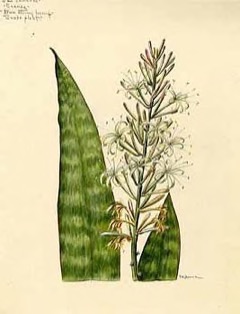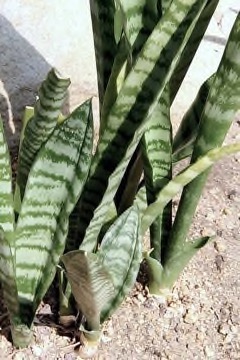 |
|
edibleplants.org |
 |
| Wikimedia.org - Peter A. Mansfeld |
Translate this page:
Summary
Physical Characteristics

 Sansevieria trifasciata is an evergreen Perennial growing to 0.8 m (2ft 6in) by 0.2 m (0ft 8in) at a medium rate.
Sansevieria trifasciata is an evergreen Perennial growing to 0.8 m (2ft 6in) by 0.2 m (0ft 8in) at a medium rate.
See above for USDA hardiness. It is hardy to UK zone 10.
Suitable for: light (sandy), medium (loamy) and heavy (clay) soils, prefers well-drained soil and can grow in heavy clay and nutritionally poor soils. Suitable pH: mildly acid, neutral and basic (mildly alkaline) soils. It can grow in semi-shade (light woodland) or no shade. It prefers dry or moist soil and can tolerate drought.
UK Hardiness Map
US Hardiness Map
Synonyms
Sansevieria craigii auct. Sansevieria jacquinii N.E.Br. Sansevieria laurentii De Wild. Sansevieria zeylanica laurentii (De Wild.) L.H.Bailey
Plant Habitats
Edible Uses
References More on Edible Uses
Medicinal Uses
Plants For A Future can not take any responsibility for any adverse effects from the use of plants. Always seek advice from a professional before using a plant medicinally.
The plant is used to treat ringworm and fungal diseases[311 ]. The leaf sap is applied directly on infected sores, cuts and grazes, it is also used to treat fungal and scabies infections[481 ].
References More on Medicinal Uses
The Bookshop: Edible Plant Books
Our Latest books on Perennial Plants For Food Forests and Permaculture Gardens in paperback or digital formats.

Edible Tropical Plants
Food Forest Plants for Hotter Conditions: 250+ Plants For Tropical Food Forests & Permaculture Gardens.
More

Edible Temperate Plants
Plants for Your Food Forest: 500 Plants for Temperate Food Forests & Permaculture Gardens.
More

More Books
PFAF have eight books available in paperback and digital formats. Browse the shop for more information.
Shop Now
Other Uses
A fibre obtained from the leaves is used to make string, mats etc[302 ]. The leaf pulp is used for cosmetics[317 ]. The NASA Clean Air Study found S. trifasciata has air purification qualities, removing 4 of the 5 main toxins. widely used as an ornamental, in both the tropics outdoors in both pots and garden beds and as an indoor plant in temperate areas. It is popular as a houseplant because it is tolerant of low light levels and irregular watering; during winter it needs only one watering every couple of months. It will rot easily if overwatered.The variety S. trifasciata var. laurentii and the cultivar 'Bantel's Sensation' have both gained the Royal Horticultural Society's Award of Garden Merit. Industrial Crop: Fiber.
Special Uses
Carbon Farming
References More on Other Uses
Cultivation details
Industrial Crop: Fiber Management: Hay Minor Global Crop
Prefers a well-drained soil in a sunny or partially shaded position[302 ], and a pH between 6 and 7[200 ]. Bright sunlight can lead to bleaching of leaf colour[302 ]. Established plants are drought tolerant[200 ].
Carbon Farming
-
Industrial Crop: Fiber
Clothing, rugs, sheets, blankets etc. Currently, almost none of our fiber are produced from perennial crops but could be!
-
Management: Hay
Cut to the ground and harvested annually. Non-destructive management systems maintaining the soil organic carbon.
-
Minor Global Crop
These crops are already grown or traded around the world, but on a smaller scale than the global perennial staple and industrial crops, The annual value of a minor global crop is under $1 billion US. Examples include shea, carob, Brazil nuts and fibers such as ramie and sisal.
References Carbon Farming Information and Carbon Sequestration Information
Temperature Converter
Type a value in the Celsius field to convert the value to Fahrenheit:
Fahrenheit:
The PFAF Bookshop
Plants For A Future have a number of books available in paperback and digital form. Book titles include Edible Plants, Edible Perennials, Edible Trees,Edible Shrubs, Woodland Gardening, and Temperate Food Forest Plants. Our new book is Food Forest Plants For Hotter Conditions (Tropical and Sub-Tropical).
Shop Now
Plant Propagation
It can be propagated by cuttings, by dividing the rhizome and by seed. The first method has the disadvantage that the variegation will be lost.
Other Names
If available other names are mentioned here
Common Names: English: good-luck plant; iguanatail; konje hemp; snake plant; viper’s bowstring hemp. Spanish: lengua de suegra; lengua de vaca; sansevieria. French: chanvre d'Afrique; langue de belle-mère. Local Common Names: Cook Islands: riri. Costa Rica: Espada de Judas; Espada del Diablo. Germany: Bogenhanf. Guam: tigre. Jamaica: tiger cat. Lesser Antilles: oreillo di burian; rhamni; yerba ci cinta; yerba di colebas. Palau: kitelel. Tonga: alelo; elelo; ngata.
Native Range
AFRICA: Democratic Republic of the Congo, Nigeria (north)
Weed Potential
Right plant wrong place. We are currently updating this section.
Please note that a plant may be invasive in one area but may not in your area so it's worth checking.
S. trifasciata is a very aggressive invasive plant able to grow in a great range of sunlit exposures (from complete sunny open areas to partial shaded areas). Additionally, this species is drought and heat tolerant (Gilman, 1999). Segments of leaves and rhizomes resprout easily and grow rapidly forming dense and virtually impenetrable thickets (Arnold, 2004). S. trifasciata is a succulent perennial herb included in the Global Compendium of Weeds and considered a “noxious weed” (Randall, 2012).
Conservation Status
IUCN Red List of Threatened Plants Status : This taxon has not yet been assessed

Growth: S = slow M = medium F = fast. Soil: L = light (sandy) M = medium H = heavy (clay). pH: A = acid N = neutral B = basic (alkaline). Shade: F = full shade S = semi-shade N = no shade. Moisture: D = dry M = Moist We = wet Wa = water.
Now available:
Food Forest Plants for Mediterranean Conditions
350+ Perennial Plants For Mediterranean and Drier Food Forests and Permaculture Gardens.
[Paperback and eBook]
This is the third in Plants For A Future's series of plant guides for food forests tailored to
specific climate zones. Following volumes on temperate and tropical ecosystems, this book focuses
on species suited to Mediterranean conditions—regions with hot, dry summers and cool, wet winters,
often facing the added challenge of climate change.
Read More
Expert comment
Author
Prain.
Botanical References
Links / References
For a list of references used on this page please go here
A special thanks to Ken Fern for some of the information used on this page.
Readers comment
| Add a comment |
|
If you have important information about this plant that may help other users please add a comment or link below. Only comments or links that are felt to be directly relevant to a plant will be included. If you think a comment/link or information contained on this page is inaccurate or misleading we would welcome your feedback at [email protected]. If you have questions about a plant please use the Forum on this website as we do not have the resources to answer questions ourselves.
* Please note: the comments by website users are not necessarily those held by PFAF and may give misleading or inaccurate information.
To leave a comment please Register or login here All comments need to be approved so will not appear immediately.
|
Subject : Sansevieria trifasciata
|
|
|
|